
Shooting sports is a group of competitive and recreational sporting activities involving proficiency tests of accuracy, precision and speed in shooting — the art of using ranged weapons, mainly small arms and bows/crossbows.
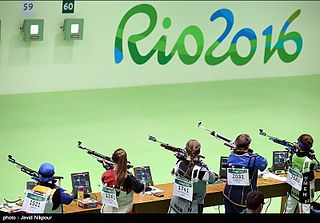
The International Shooting Sport Federation recognizes several shooting events, some of which have Olympic status. They are divided into four disciplines: rifle, pistol, shotgun and running target.
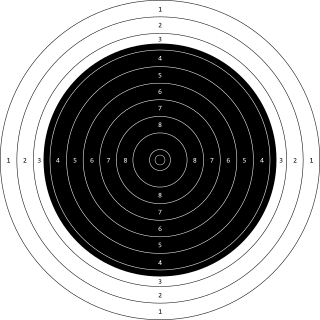
International Rifle events that occur in three positions are conducted with an equal number of shots fired from the Kneeling, Prone and Standing positions, although the order has changed over the years. Each of the three positions shot during the match has a fixed time limit that the shooter is able to shoot unlimited numbers of sighting shots and 10 or 20 shots for record.

Metallic silhouette shooting is a group of target shooting disciplines that involves shooting at steel targets representing game animals at varying distances, seeking to knock the metal target over. Metallic silhouette is shot with large bore rifles fired freehand without support out to 500 meters, and with large bore handguns from the prone position with only body support out to 200 meters. Competitions are also held with airguns and black-powder firearms. A related genre is shot with bow and arrow, the metal targets being replaced with cardboard or foam. The targets used are rams, turkeys, pigs, and chickens, which are cut to different scales and set at certain distances from the shooter depending on the specific discipline.

The International Practical Shooting Confederation (IPSC) is the world's largest shooting sport association, and the largest and oldest within practical shooting. Founded in 1976, the IPSC nowadays affiliates over 100 regions from Africa, Americas, Asia, Europe, the Middle East, and Oceania. Competitions are held with pistols, revolvers, rifles, and shotguns, and the competitors are divided into different divisions based on firearm and equipment features. While everyone in a division competes in the Overall category, there are also separate awards for the categories Lady, Super Junior, Junior, Senior, and Super Senior.

Prone position is a body position in which the person lies flat with the chest down and the back up. In anatomical terms of location, the dorsal side is up, and the ventral side is down. The supine position is the 180° contrast.

10 metre air rifle is an International Shooting Sports Federation (ISSF) shooting event, shot at a bullseye target over a distance of 10 meters using a 4.5 mm (0.177 in) calibre air rifle with a maximum weight of 5.5 kg (12.13 lb). It is one of the ISSF-governed shooting sports included in the Summer Olympics since the 1984 Los Angeles Games.
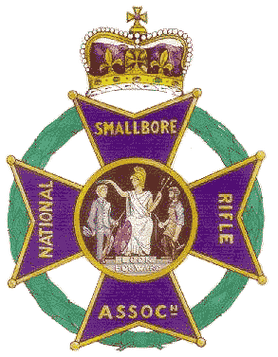
The National Small-bore Rifle Association (NSRA) is the national governing body for all small-bore rifle and pistol target shooting in the United Kingdom, including airgun and match crossbow shooting.
Natural point of aim, also known as natural aiming area (NAA), is a shooting skill where the shooter minimizes the effects of body movement on the firearm's impact point. Along with proper stance, sight alignment, sight picture, breath control, and trigger control, it forms the basis of marksmanship.

Field target is an outdoor airgun field shooting sport. Competitions are usually fired at self indicating steel targets placed between 9 and 50 m. There are two classes; Piston for spring-piston air guns, and PCP for pre-charged pneumatic air guns. In sanctioned competitions, the same competition rule set is used around most of the world. A small match can consist of 40 to 60 rounds, while the world championship consists of 150 rounds. It is common to use scope sights with high magnification and a short depth of field such that an adjustable parallax knob can be used to precisely determine the target distance. The target kill zones have three standardised sizes, which are 15 mm, 25 mm or 40 mm.
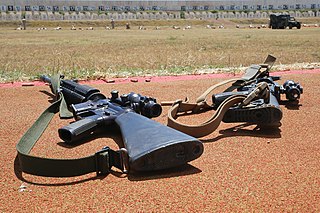
In the context of firearms, a sling is a type of strap or harness designed to allow a shooter to conveniently carry a firearm on their body, and/or to aid in greater hit probability by allowing the firearm to be better braced and stabilized during aiming. Various types of slings offer their own advantages and disadvantages, and can generally be divided into several categories.

Paralympic shooting, also known as shooting Para sport, is an adaptation of shooting sports for competitors with disabilities. Shooting is a test of accuracy and control, in which competitors use pistols or rifles to fire a series of shots at a stationary target. Each shot is worth a maximum score of 10.9 points. Athletes use .22 caliber rifles, pistols and .177 caliber air guns. Paralympic shooting first appeared in the Summer Paralympics at the 1976 Toronto Games.

300 m rifle three positions is an ISSF shooting event, involving shooting 40 shots each from the prone, the standing and the kneeling positions. Men and women both shoot the same number of shots, though previously women only shot half the course – or 20 shots in each position.

High Power Rifle, also called XTC from "Across the Course", is a shooting sport using fullbore target rifles which is arranged in the United States by the National Rifle Association of America (NRA). The sport is divided into classes by equipment, and popular types of matches include Service Rifle, Open, Axis and Allies and metallic silhouette. The term High Power Rifle sometimes also includes the international shooting disciplines of Palma and F-Class by the International Confederation of Fullbore Rifle Associations (ICFRA) which are represented by the NRA in the United States.

Smallbore rifle shooting, sometimes known as miniature rifle shooting, is a set of disciplines of shooting sports. Smallbore shooting uses smaller-calibre rifles, typically chambered in .22 Long Rifle, at ranges generally of 100 yards (91 m) or shorter. Depending on the range, it can either be conducted indoors or outdoors.
The Art of the Rifle is a concise book explaining the use and techniques of rifles. It was authored by Lt. Col. (R) Jeff Cooper (1920–2006) and published in 1997. In it, Cooper uses short chapters to teach about both physical and mental preparedness for successful rifle shooting, whether for defense, hunting, or competition. His goal was to help the rifle shooter be accurate at any time or place. Col. Cooper was particularly well known for his pistol shooting expertise, popularizing the widely used “Weaver stance” and establishing a large training center in Arizona for military, law enforcement and civilians interested in gaining skill with firearms and defense techniques. Col. Cooper also authored at least half a dozen other books related to shooting since the 1950s. As of 2012, The Art of the Rifle was still in print in hardcover, softcover and electronic formats.

Shooting targets are objects in various forms and shapes that are used for pistol, rifle, shotgun and other shooting sports, as well as in darts, target archery, crossbow shooting and other non-firearm related sports. The center is often called the bullseye. Targets can for instance be made of paper, "self healing" rubber or steel. There are also electronic targets that electronically can provide the shooter with precise feedback of the shot placement.

Multigun, Multi Gun or Multi-Gun, often also called 2-Gun or 3-Gun depending on the types of firearms used, are practical shooting events where each of the stages require the competitor to use a combination of handguns, rifles, and/or shotguns Multigun has a lot in common with ordinary IPSC/ USPSA single gun matches, and matches generally have courses of fire where the shooter must move through different stages and engage targets in a variety of different positions.
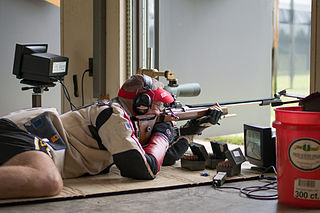
Bullseye shooting is a category of shooting sport disciplines where the objective is to score points with carefully placed precision fire by hitting a target as close to its center as possible. The name refers to the target center's nickname, the "bull's eye". In Scandinavia, this type of shooting competition is referred to as Range-Shooting, as it usually takes place at dedicated shooting range.
























